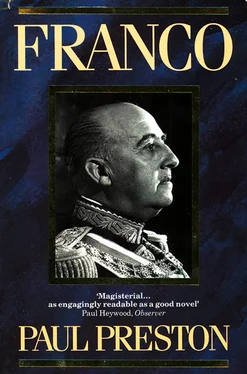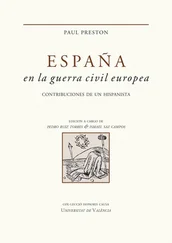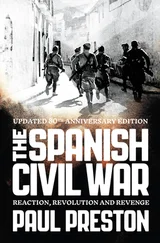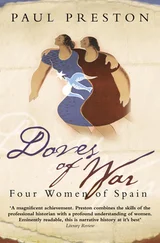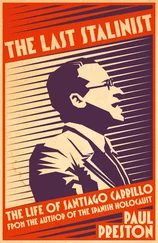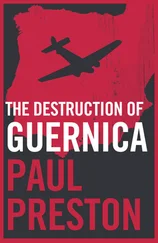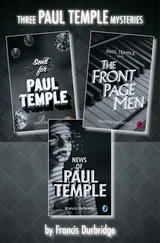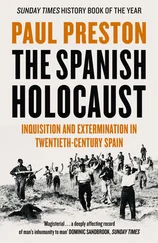Paul Preston - Franco
Здесь есть возможность читать онлайн «Paul Preston - Franco» — ознакомительный отрывок электронной книги совершенно бесплатно, а после прочтения отрывка купить полную версию. В некоторых случаях можно слушать аудио, скачать через торрент в формате fb2 и присутствует краткое содержание. Жанр: unrecognised, на английском языке. Описание произведения, (предисловие) а так же отзывы посетителей доступны на портале библиотеки ЛибКат.
- Название:Franco
- Автор:
- Жанр:
- Год:неизвестен
- ISBN:нет данных
- Рейтинг книги:5 / 5. Голосов: 1
-
Избранное:Добавить в избранное
- Отзывы:
-
Ваша оценка:
- 100
- 1
- 2
- 3
- 4
- 5
Franco: краткое содержание, описание и аннотация
Предлагаем к чтению аннотацию, описание, краткое содержание или предисловие (зависит от того, что написал сам автор книги «Franco»). Если вы не нашли необходимую информацию о книге — напишите в комментариях, мы постараемся отыскать её.
Franco — читать онлайн ознакомительный отрывок
Ниже представлен текст книги, разбитый по страницам. Система сохранения места последней прочитанной страницы, позволяет с удобством читать онлайн бесплатно книгу «Franco», без необходимости каждый раз заново искать на чём Вы остановились. Поставьте закладку, и сможете в любой момент перейти на страницу, на которой закончили чтение.
Интервал:
Закладка:
* Assuming that Franco would attack through Cordoba, and believing the Yagüe columns to be engaged only in local operations, the Republican General Miaja had concentrated his exiguous defensive forces on the Córdoba-Madrid line.
* The Francoist military historian, Colonel José Manuel Martínez Bande, has seen this message as the first sign of Franco’s decision to relieve the Alcázar de Toledo. His view is based entirely on the presence in the message of the words: ‘Maqueda-Toledo’, which he arbitrarily takes to mean ‘relief of the Alcázar’. However, the rest of Franco’s text shows rather that after Maqueda the column would make a continued thrust to Madrid in a direct line to Navalcarnero rather than make any diversion to Toledo.
VII
THE MAKING OF A CAUDILLO
August – November 1936
THE SUCCESSES of the African columns and the imminent attack on Talavera led, on 26 August, to Franco transferring his headquarters from Seville to the elegant sixteenth century Palacio de los Golfines de Arriba in Cáceres. He was anxious to move on from Seville in order to establish his total autonomy, free from the interference or disdain of Queipo de Llano in whose presence he always felt uncomfortable. 1 Like his earlier choice of the Palacio de Yanduri in Seville, it indicated a jealous concern for his public status. Franco was beginning to build a political apparatus capable of daily dealings with the Germans and Italians. Already he had a diplomatic office, headed by José Antonio de Sangróniz. Lieutenant-Colonel Lorenzo Martínez Fuset acted as legal adviser and political secretary. Franco was also accompanied from time to time by his brother Nicolás, who travelled between Cáceres and Lisbón where he was working for the Nationalist cause. Nicolás would soon be acting as a kind of political factotum. Millán Astray was in charge of propaganda. Even at this early stage, the tone of Franco’s entourage was sycophantic. 2
The sheer volume of work facing Franco, effectively co-ordinating Nationalist ‘foreign policy’ and logistical organization, as well as maintaining close overall supervision of the advance of the African columns, obliged him to work immensely long hours. His resistance to discomfort and the powers of endurance which he had displayed as a young officer in Africa were undiminished but he began to age noticeably. The manic Millán Astray boasted to Ciano that ‘our Caudillo spends fourteen hours at his desk and doesn’t get up even to piss’. 3 When his wife and daughter returned to Spain after their two-month exile in France – on 23 September – he responded to the announcement of their arrival by sending them a message that he had important visitors waiting. They were obliged to wait for more than an hour. He had little time for family life. 4 Such concentration and strain perhaps contributed to the quenching of his early optimism but the re-emergence of a cautious Franco after the brief reincarnation of the impetuous African hero denoted both the prospect of power and the growing strength of Republican resistance.
The difficulties that were now slowing down the advance of the African columns impelled Franco’s Italian and German allies to step up their assistance. On 27 August, accompanied by Lieutenant-Colonel Walter Warlimont of the War Ministry staff, Canaris met Roatta in Rome to co-ordinate their views on the scale and nature of future assistance from Italy and Germany to the Nationalists. At a further meeting on the following day, they were joined by Ciano. Canaris again insisted that assistance be provided ‘only to General Franco, because he holds the supreme command of operations’. Joint Italo-German planning required a recognizable overall Nationalist commander with whom to communicate. 5
Talavera was encircled by the three columns. The propaganda value for the Nationalists of the massacre at Badajoz was revealed when large numbers of militiamen fled in buses ‘like a crowd after a football match’. The town fell on 3 September. Another savage and systematic massacre ensued. 6 While Franco’s forces had been moving through Extremadura and into New Castile, Mola had begun an attack on the Basque province of Guipúzcoa to cut the province off from France. Irún and San Sebastián were attacked daily by Italian bombers and bombarded by the Nationalist fleet. Irún’s poorly armed and untrained militia defenders fought bravely but were overwhelmed on 3 September. San Sebastián fell on 12 September. It was a key victory for the Nationalists. Guipúzcoa was a rich agrarian province which also contained important heavy industries. The Nationalist zone was now united in a single block from the Pyrenees through Castille and western Spain to the far south. The Republican provinces of Vizcaya, Santander and Asturias were isolated, able to communicate with the rest of the Republic only by sea or air. 7
The losses of Talavera and Irún provoked the fall of the government of José Giral. A cabinet which more clearly reflected the working class bases of the Republic was introduced under the leadership of Francisco Largo Caballero. The clearer definition of the Republic and its move towards a stronger central authority was the corollary of the ever fiercer resistance being mounted against Franco’s advancing columns. The reduction of political indecision on the Republican side intensified the feeling among the senior Nationalist commanders that a unified command was an urgent necessity. Franco’s ambitions could be deduced from a statement to the Germans in Morocco that he wished ‘to be looked upon not only as the saviour of Spain but also as the saviour of Europe from the spread of Communism’. 8 Now, the issue of a single command opened an opportunity for him. Mola flew to Cáceres on 29 August and discussed the matter with him. 9
In the meanwhile, the bulk of Nationalist success was being chalked up by Franco’s Army of Africa. Protected to the south by the Tagus, Yagüe’s troops secured their northern flank by linking up with Mola’s forces. With the road to Madrid now open, for the next two weeks desperate Republican counter-attacks sought to recapture Talavera, but Franco showed a dogged resolve not to give up an inch of captured ground. Stiffening resistance and Franco’s determination to purge territory of leftists as it was captured account for the slowing down of his advance. In fact, he was on the verge of slowing it down even further by a momentous decision.
Among the issues crowding in on him, Franco gave some thought to the besieged garrisons of Toledo and Santa María de la Cabeza in Jaén. He regularly released his own Douglas DC-2 aircraft and his pilot Captain Haya for missions to both fortresses. On 22 August, he had sent a message to the Alcázar de Toledo promising to bring relief. 10 The fortress was still unsuccessfully besieged by Republican militiamen who had wasted time, energy and ammunition in trying to capture this strategically unimportant stronghold. The one thousand Civil Guards and Falangists who had retreated into the Alcázar in the early days of the rising, had taken with them as hostages many women and children, the families of known leftists. 11 However, the resistance of the Alcázar was being turned into the great symbol of Nationalist heroism. Subsequently, the reality of the siege would be embroidered beyond recognition, in particular through the famous, and almost certainly apocryphal, story that Moscardó was telephoned and told that, unless he surrendered, his son would be shot. * Naturally, the existence, and subsequent fate, of the hostages was entirely forgotten. 12
Franco’s troops took more than two weeks to cover the ground from Talavera to the town of Santa Olalla in the province of Toledo on the road to Madrid. 13 On 20 September, Yagüe’s forces captured Santa Olalla and imposed another ‘exemplary punishment’ on the militiamen they captured. 14 Maqueda, at the cross-roads where the road divided to go either north to Madrid or east to Toledo, also fell to Yagüe on 21 September. At this point, that is to say after the fall of Maqueda, Franco had to make the decision whether to let the African columns race onto Madrid or else turn eastwards to relieve Toledo. It was a complex decision with political as well as military implications. While Yagüe was capturing Santa Olalla and Maqueda, Franco had been engaged in meetings with the other generals of the Junta de Defensa Nacional to discuss the need for a single Commander-in-Chief for the Nationalist forces. It is immensely difficult to reconstruct in precise detail the where, when, why and how of Franco’s decision but a key is to be found in the role of Yagüe.
Читать дальшеИнтервал:
Закладка:
Похожие книги на «Franco»
Представляем Вашему вниманию похожие книги на «Franco» списком для выбора. Мы отобрали схожую по названию и смыслу литературу в надежде предоставить читателям больше вариантов отыскать новые, интересные, ещё непрочитанные произведения.
Обсуждение, отзывы о книге «Franco» и просто собственные мнения читателей. Оставьте ваши комментарии, напишите, что Вы думаете о произведении, его смысле или главных героях. Укажите что конкретно понравилось, а что нет, и почему Вы так считаете.
